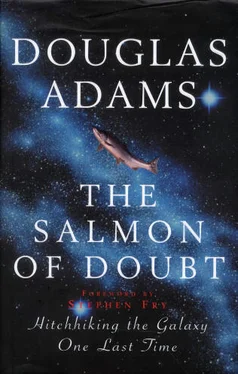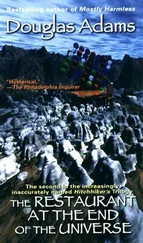2000—let’s not pretend that we didn’t have a warning that the century was going to end! I think that we need to take a larger perspective on who we are and what we are doing here if we are going to survive in the long term.
I rather love that notion, and, as I was discussing with someone earlier today, there’s a book I thoroughly enjoyed recently by David Deutsch, who is an advocate of the multiple-universe view of the universe, called The Fabric of Reality, in which he explores the notion of a quantum multiple-universe view of the universe. This came from the famous wave/particle dichotomy about the behaviour of light—that you couldn’t measure it as a wave when it behaves as a wave, or as a particle when it behaves as a particle. How does this come to be? David Deutsch points out that if you imagine that our universe is simply one layer and that there is an infinite multiplicity of universes spreading out on either side, not only does it solve the problem, but the problem simply goes away. This is exactly how you expect light to behave under those circumstances. Quantum mechanics has claims to be predicated on the notion that the universe behaves as if there were a multiplicity of universes, but it rather strains our credulity to think that there actually would be.
This goes straight back to Galileo and the Vatican. In fact, what the Vatican said to Galileo was, “We don’t dispute your readings, we just dispute the explanation you put on them. It’s all very well for you to say that the planets sort of do that as they go round and it is as if we were a planet and those planets were all going round the sun; it’s all right to say it’s as if that were happening, but you’re not allowed to say that’s what is happening, because we have a total lockhold on universal truth and also it simply strains our personal credulity.” Just so, I think that the idea that there are multiple universes currently strains our credulity, but it may well be that it’s simply one more strain that we have to learn to live with, just as we’ve had to learn to live with a whole bunch of them in the past.
The next age of sand is the microscopic one. We put glass lenses into microscopes and started to look down at the microscopic view of the universe. Then we began to understand that when we get down to the subatomic level, the solid world we live in also consists, again rather worryingly, of almost nothing and that wherever we do find something it turns out not to actually something, but only the probability that there may something there.
One way or another, this is a deeply misleading universe. Wherever we look, it’s beginning to be extremely alarming and extremely upsetting to our sense of who we are—great, strapping, physical people living in a universe that exists almost entirely for us—that it just isn’t the case. At this point we still divining from this all sorts of fundamental principles, recognising the way that gravity works, the way that strong and weak nuclear forces work, recognising the nature of matter, the nature of particles and so on, but having got those fundamentals, we’re still not very good at figuring out how it works, because the maths is really rather tricky. So we tend to come up with almost a clockwork view of the way it all works because that’s the best our math can manage. I don’t mean in any way to disparage Newton, because I guess he was the first person who saw that there were principles at work that were different from anything we actually saw around us. His first law of motion—that something will remain in its position of either rest or motion until some other force works on it—is something that none of us, living in a gravity well, in a gas envelope, had ever seen, because everything we move comes to a halt. It was only through very, very careful watching and observing and measuring and divining the principles underlying what we could all see happening that he came up with the principles that we all know and recognise as being the laws of motion, but nevertheless it is, by modern terms, still a somewhat clockwork view of the universe.
As I say, I don’t mean that to sound disparaging in any way at all, because his achievements, as we all know, were absolutely monumental, but it still kind of doesn’t make sense to us.
Now there are all sorts of entities we are also aware of, as well as particles, forces, tables, chairs, rocks, and so on, that are almost invisible to science; almost invisible, because science has almost nothing to say about them whatsoever. I’m talking about dogs and cats and cows and each other. We living things are so far beyond the purview of anything science can actually say, almost beyond even recognising ourselves as things that science might be expected to have something to say about.
I can imagine Newton sitting down and working out his laws of motion and figuring out the way the universe works and with him, a cat wandering around. The reason we had no idea how cats worked was because, since Newton, we had proceeded by the very simple principle that essentially, to see how things work, we took them apart. If you try to take a cat apart to see how it works, the first thing you have in your hands is a nonworking cat. Life is a level of complexity that almost lies outside our vision; is so far beyond anything we have any means of understanding that we just think of it as a different class of object, a different class of matter; “life,” something that had a mysterious essence about it, was God-given—and that’s the only explanation we had. The bombshell comes in 1859 when Darwin publishes the Origin of Species. It takes a long time before we really get to grips with this and begin understand it, because not only does it seem incredible and thoroughly demeaning to us, but it’s yet another shock to our system to discover that not only are we not the centre of universe and we’re not made of anything, but we started out as some kind of slime and got to where we are via being a monkey.
It just doesn’t read well. But also, we have no opportunity to see this stuff at work. In a sense Darwin was like Newton in that he was the first person to see underlying principles really were not at all obvious, from the everyday world in which he lived. We had to think very hard to understand the nature of what was happening around us, and we had no clear obvious everyday examples of evolution to point to. Even today that persists as a slightly tricky problem if you’re trying to persuade somebody who doesn’t believe in all this evolution stuff and wants you to show him an example—they are hard to find in terms of everyday observation. So we come to the third age of sand. In the third age of sand we discover something else we can make out of sand—silicon. We make the silicon chip—and suddenly what opens up to us is a universe not of fundamental particles and fundamental forces, but of the things that were missing in that picture that told us how they work; what the silicon chip revealed to us was the process.
The silicon chip enables us to do mathematics tremendously fast, to model the—as it turns out—very, very simple processes that are analogous to life in terms of their simplicity; iteration, looping, branching, the feedback loop that lies at the heart of everything you do on a computer and at the heart of everything that happens in evolution—that is, the output stage of one generation becomes the input stage of the next.
Suddenly we have a working model—not for a while, because early machines are terribly slow and clunky—but gradually we accumulate a working model of this thing that previously we could only guess at or deduce—and you had to be a pretty sharp and a pretty clear thinker even to divine it happening when it was far from obvious and indeed counterintuitive, particularly to as proud a species as we.
Читать дальше










